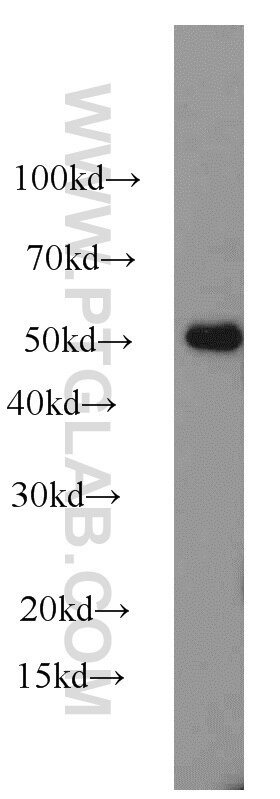Anticorps Polyclonal de lapin anti-Phospho-Smtnl1 (Ser301)
Phospho-Smtnl1 (Ser301) Polyclonal Antibody for WB, ELISA
Hôte / Isotype
Lapin / IgG
Réactivité testée
souris
Applications
WB, ELISA
Conjugaison
Non conjugué
N° de cat : 19560-1-AP
Synonymes
Galerie de données de validation
Applications testées
| Résultats positifs en WB | tissu vésical de souris, |
Dilution recommandée
| Application | Dilution |
|---|---|
| Western Blot (WB) | WB : 1:500-1:1000 |
| It is recommended that this reagent should be titrated in each testing system to obtain optimal results. | |
| Sample-dependent, check data in validation data gallery | |
Applications publiées
| WB | See 1 publications below |
Informations sur le produit
19560-1-AP cible Phospho-Smtnl1 (Ser301) dans les applications de WB, ELISA et montre une réactivité avec des échantillons souris
| Réactivité | souris |
| Réactivité citée | souris |
| Hôte / Isotype | Lapin / IgG |
| Clonalité | Polyclonal |
| Type | Anticorps |
| Immunogène | Peptide |
| Nom complet | smoothelin-like 1 |
| Masse moléculaire calculée | 49 kDa |
| Poids moléculaire observé | 50 kDa |
| Numéro d’acquisition GenBank | NM_024230 |
| Symbole du gène | Smtnl1 |
| Identification du gène (NCBI) | 68678 |
| Conjugaison | Non conjugué |
| Forme | Liquide |
| Méthode de purification | Purification par affinité contre l'antigène |
| Tampon de stockage | PBS with 0.02% sodium azide and 50% glycerol |
| Conditions de stockage | Stocker à -20°C. Stable pendant un an après l'expédition. L'aliquotage n'est pas nécessaire pour le stockage à -20oC Les 20ul contiennent 0,1% de BSA. |
Informations générales
Smtnl1 belongs to the smoothelin family. The antibody recognize Ser(301) phospho of Smtn1.
Protocole
| Product Specific Protocols | |
|---|---|
| WB protocol for Phospho-Smtnl1 (Ser301) antibody 19560-1-AP | Download protocol |
| Standard Protocols | |
|---|---|
| Click here to view our Standard Protocols |


